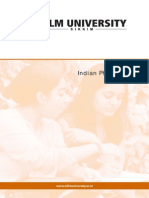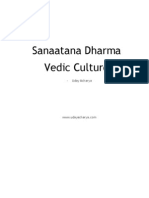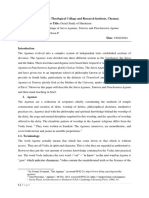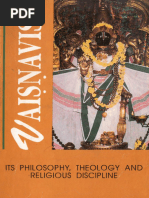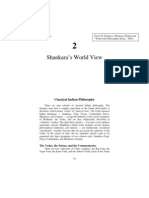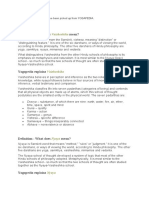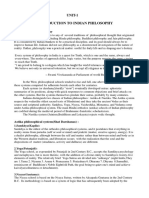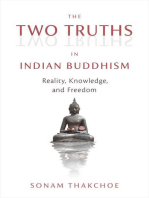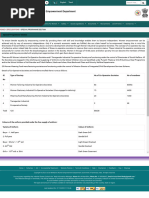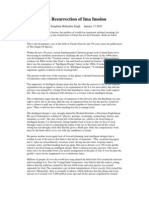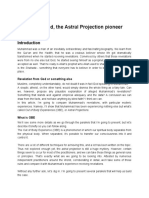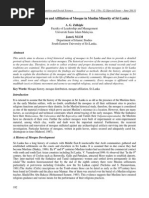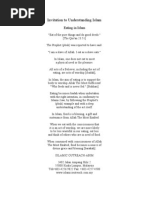0 ratings0% found this document useful (0 votes)
4 viewsBlock-1 7
Block-1 7
Uploaded by
mail2sasiThe document discusses heterodox and orthodox systems in Indian philosophy. It introduces Carvaka, Jainism and Buddhism as heterodox systems. It then discusses six orthodox systems - Nyaya, Vaisheshika, Samkhya, Yoga, Mimamsa and Vedanta. It provides details on the three prominent schools of Vedanta - Advaita, Vishistadvaita and Dvaita. It also discusses Shaivism and Vaishnavism.
Copyright:
© All Rights Reserved
Available Formats
Download as PDF, TXT or read online from Scribd
Block-1 7
Block-1 7
Uploaded by
mail2sasi0 ratings0% found this document useful (0 votes)
4 views1 pageThe document discusses heterodox and orthodox systems in Indian philosophy. It introduces Carvaka, Jainism and Buddhism as heterodox systems. It then discusses six orthodox systems - Nyaya, Vaisheshika, Samkhya, Yoga, Mimamsa and Vedanta. It provides details on the three prominent schools of Vedanta - Advaita, Vishistadvaita and Dvaita. It also discusses Shaivism and Vaishnavism.
Original Description:
Indian Philosophy Vol. 1
Copyright
© © All Rights Reserved
Available Formats
PDF, TXT or read online from Scribd
Share this document
Did you find this document useful?
Is this content inappropriate?
The document discusses heterodox and orthodox systems in Indian philosophy. It introduces Carvaka, Jainism and Buddhism as heterodox systems. It then discusses six orthodox systems - Nyaya, Vaisheshika, Samkhya, Yoga, Mimamsa and Vedanta. It provides details on the three prominent schools of Vedanta - Advaita, Vishistadvaita and Dvaita. It also discusses Shaivism and Vaishnavism.
Copyright:
© All Rights Reserved
Available Formats
Download as PDF, TXT or read online from Scribd
Download as pdf or txt
0 ratings0% found this document useful (0 votes)
4 views1 pageBlock-1 7
Block-1 7
Uploaded by
mail2sasiThe document discusses heterodox and orthodox systems in Indian philosophy. It introduces Carvaka, Jainism and Buddhism as heterodox systems. It then discusses six orthodox systems - Nyaya, Vaisheshika, Samkhya, Yoga, Mimamsa and Vedanta. It provides details on the three prominent schools of Vedanta - Advaita, Vishistadvaita and Dvaita. It also discusses Shaivism and Vaishnavism.
Copyright:
© All Rights Reserved
Available Formats
Download as PDF, TXT or read online from Scribd
Download as pdf or txt
You are on page 1of 1
nāstikas and those which accept the validity of Veda are called the orthodox
systems or āstikas. Cārvāka, Jainism and Buddhism are nāstika or heterodox
systems. The fourth block is on the Heterodox Systems, which includes four
units. This block introduces Metaphysics, epistemology and ethics of Cārvaka,
Jain and Buddhist Schools. In this block you will study the early Buddhism
and also various schools of Buddhism. You will see the development of not
only Buddhism, but also the glimps of dialogical tradition of Indian Philosophy.
How the various interpretations of one text or one teaching give birth of many
philosophical positions. It is not only true for Buddhism, but also true for All
Indian Philosophical systems.
The final block is on the Orthodox Systems which includes five units. All Indian
philosophies can be seen to have a common theme of unity and diversity (advaita
and dvaita) in their understanding and interpretation of reality, and attempt to
explain the attainment of liberation (moks̩ a). They had been formulated chiefly
from 1,500 BC to a few centuries A.D, with critical investigations and creative
ways of philosophically interpreting even socio-political-economic issues of
existential importance continuing up to as late as the 21 century by Amartya Sen
and others. The units of this block discuss metaphysics, epistemology, ethics,
idea of God, salvation of Nyāya, Vaiśes̩ ika, Sāṅkhya, Yoga, and Mīmāṁsā. This
block also discusses various different views found in a school. Nyāya-Vaiśes̩ ika
and Sāṅkhya- Yoga, Mīmāṁsā-Vedānta is considered as an allied system of
Indian school of thought.
This block also discusses the philosophies of Vedānta schools and Bhakti
Sampradāya (Bhakti Schools/cults). The literal meaning of the term Vedānta
is “the end of the Vedas, the concluding parts of the Vedas, the culmination
of the Vedic teaching and wisdom”. Thus the term is originally referred to
the Upanis̩ ads, the last literary products of the Vedic period. The views of the
Upanis̩ ads also constitute the final aim of the Veda, or the essence of the Vedas.
. However, Vedānta has subsequently come to include the various elaborations
and interpretations of the Upanis̩ ads. Thus the Upanis̩ ads abound in terse and
aphoristic statements replete with inspiring meanings. Scintillating significance
and dynamic intuition are packed into such short and powerful utterances.
Precisely for these reasons the Upanis̩ ads give rise to diverse interpretations. In
course of time, there emerged different schools of Vedānta, the prominent ones
being Advaita (non-dualism) of Śaṁkara, Viśis̩ t̩ ādvaita (Qualified Nondualism)
of Rāmānuja and Dvaita (Dualism) of Madhva. Each of these is going to be
explored in detail, in the units two, three and four of the block. The final unit is
on Śaivism and Vais̩ n̩ avism, which are two very popular forms of Hindu faith
with large numbers of followers. Lord Śiva and Lord Vis̩ n̩ u are worshiped as
Supreme Being respectively in these religious traditions. However, in popular
Hinduism Śiva is one of the Trinity and carries on the function of Annihilation,
while Brahmā and Vis̩ n̩ u are said to be the Gods of creation and sustenance
respectively. Both Śaivism and Vais̩ n̩ avism have diversified religious beliefs and
practices. Various sects of them are found all over India. They are considered
to be very ancient faiths in India. There are few direct and indirect references
to these gods in the Vedas too. Nevertheless Vedic understanding of Siva and
Vishnu was not very much developed as to regard them as Supreme Being. As a
result of medieval bhakti movements these religious traditions have witnessed a
development both in the religious sphere and in the philosophical sphere.
You might also like
- Shaiva Agamas by D. VinayDocument7 pagesShaiva Agamas by D. VinayDommeti VinayNo ratings yet
- Eastern PhilosophyDocument9 pagesEastern PhilosophyBrinzei LucianNo ratings yet
- Life's Story of Saint John Baptist de La SalleDocument59 pagesLife's Story of Saint John Baptist de La SalleJulienne BarredoNo ratings yet
- 8 Major Doctrines of SalvationDocument15 pages8 Major Doctrines of SalvationJoanna Marie Nacar100% (1)
- IKS NotesDocument82 pagesIKS NotespranavdarkundeNo ratings yet
- Indian Philosophy PDFDocument118 pagesIndian Philosophy PDFPradeep ThawaniNo ratings yet
- ASSIGNMENT Essence of Indian Knowledge and Tradition 4SEMESTER CIVILDocument9 pagesASSIGNMENT Essence of Indian Knowledge and Tradition 4SEMESTER CIVILRAHULEDITION ST20No ratings yet
- Indian PhilosophyDocument118 pagesIndian PhilosophyKavita Agnihotri100% (1)
- SLM-Philo - Systems of Indian PhilosophyDocument55 pagesSLM-Philo - Systems of Indian PhilosophyABIJITH SNo ratings yet
- Indian Philosophy PDFDocument119 pagesIndian Philosophy PDFjanvimaverick100% (1)
- Foundations of Indian PhilosophyDocument13 pagesFoundations of Indian PhilosophyHeatherDelancettNo ratings yet
- Sanaatana DharmaDocument34 pagesSanaatana DharmaUday Acharya100% (1)
- Indian PhilosophyDocument4 pagesIndian PhilosophyMisha CrutoiNo ratings yet
- 07 Chapter2Document66 pages07 Chapter2VenugopalNo ratings yet
- The New BookDocument40 pagesThe New BookAdiNo ratings yet
- ASSIGNMENT Essence of Indian Knowledge and Tradition completeDocument15 pagesASSIGNMENT Essence of Indian Knowledge and Tradition completetmillmgk12No ratings yet
- Indian PhilosophyDocument80 pagesIndian PhilosophydvdmegaNo ratings yet
- BHUDASIMDocument60 pagesBHUDASIMlabizaNo ratings yet
- Balinese Hinduism and TheologyDocument8 pagesBalinese Hinduism and TheologyBalu SamyNo ratings yet
- 5.5. Main Teaching of Saiva Agamas, Tantras and Pancharatra AgamasDocument11 pages5.5. Main Teaching of Saiva Agamas, Tantras and Pancharatra AgamassindhujapreslyNo ratings yet
- Introduction Indian PhilosophyDocument80 pagesIntroduction Indian PhilosophyAmrith VardhanNo ratings yet
- BeliefDocument57 pagesBeliefraghavendra8533936No ratings yet
- 101Document15 pages101Atri ChatterjeeNo ratings yet
- Itcs-Ch 3Document16 pagesItcs-Ch 3The OneNo ratings yet
- Preface: Atheism in Indian Thought'Document4 pagesPreface: Atheism in Indian Thought'ar15t0tleNo ratings yet
- Eastern Philosophy: The Greatest Thinkers and Sages from Ancient to Modern TimesFrom EverandEastern Philosophy: The Greatest Thinkers and Sages from Ancient to Modern TimesRating: 3.5 out of 5 stars3.5/5 (4)
- Sociology ProjectDocument10 pagesSociology ProjectSoumya Shefali ChandrakarNo ratings yet
- Indian Philosophy: Presented by Abhijeet Singh Ridhi WattsDocument12 pagesIndian Philosophy: Presented by Abhijeet Singh Ridhi WattsRenu JainNo ratings yet
- Sde371 PDFDocument42 pagesSde371 PDFआई सी एस इंस्टीट्यूटNo ratings yet
- Write A Short Note On VedanthaDocument13 pagesWrite A Short Note On Vedanthamuneera muniNo ratings yet
- 70 Indian Western PhilosophyDocument136 pages70 Indian Western Philosophypradeepta1810No ratings yet
- Vaisnavism Its Philosophy Theology and Religious Discipline SM Srinivasa Chari 2000Document397 pagesVaisnavism Its Philosophy Theology and Religious Discipline SM Srinivasa Chari 2000JimiNo ratings yet
- An Overview of Our Bhakti ShastrisDocument31 pagesAn Overview of Our Bhakti ShastrisDan The-Bhakti ManNo ratings yet
- Itk Unit VDocument14 pagesItk Unit Vksk.plp2808No ratings yet
- What Is Vedanta (Swami Sarvapriyananda) (Z-Library)Document25 pagesWhat Is Vedanta (Swami Sarvapriyananda) (Z-Library)faiz akhterNo ratings yet
- Philosophy Notes66Document55 pagesPhilosophy Notes66Pradeep ThawaniNo ratings yet
- Block 1 IntroDocument2 pagesBlock 1 IntroNirm alaNo ratings yet
- Parampara India: Article On HinduismDocument4 pagesParampara India: Article On HinduismDevrajNo ratings yet
- S.Y.B.a. Philosophy Paper - III Social & Political Philosophy (Eng) - RevDocument137 pagesS.Y.B.a. Philosophy Paper - III Social & Political Philosophy (Eng) - RevAnirban DeNo ratings yet
- HINDUISMDocument1 pageHINDUISMSarah May Evangelista HermoNo ratings yet
- aktu web technology unit 3Document14 pagesaktu web technology unit 3Kaustubh ManiNo ratings yet
- Shan 2 Cut PHRDocument19 pagesShan 2 Cut PHRapi-3828505No ratings yet
- Bhakti Movement in IndiaDocument8 pagesBhakti Movement in IndiadrgnarayananNo ratings yet
- Definitions of Vaiseshika, Nyaya, Mimamsa and Vedanta From YOGAPEDIADocument3 pagesDefinitions of Vaiseshika, Nyaya, Mimamsa and Vedanta From YOGAPEDIAAnjaneyulu MNo ratings yet
- Sad-Darshana-Six Systems of Vedic PhilosophyDocument77 pagesSad-Darshana-Six Systems of Vedic Philosophyraj100% (3)
- Shankara's World ViewDocument19 pagesShankara's World ViewDeep GhoshNo ratings yet
- Key Ideas On Indian PhilosophyDocument4 pagesKey Ideas On Indian PhilosophyWinston QuilatonNo ratings yet
- HinduismDocument13 pagesHinduismTrishlaNo ratings yet
- BuddhismDocument107 pagesBuddhismMajjhima ChampaNo ratings yet
- The-Secrets-of-the-VedasDocument13 pagesThe-Secrets-of-the-Vedasnamanporte055No ratings yet
- GeDocument18 pagesGeharshjindal941No ratings yet
- HinduismDocument8 pagesHinduismRezza Mae PagsolinganNo ratings yet
- Definitions of Vaiseshika, Nyaya, Mimamsa Amd Vedanta From YOGAPEDIADocument3 pagesDefinitions of Vaiseshika, Nyaya, Mimamsa Amd Vedanta From YOGAPEDIAAnjaneyulu MNo ratings yet
- Downloadessence of Indian Traditional Knowledge - Eoitk U1-5Document83 pagesDownloadessence of Indian Traditional Knowledge - Eoitk U1-5Nitish KumarNo ratings yet
- The Theravada Abhidhamma: Inquiry into the Nature of Conditioned RealityFrom EverandThe Theravada Abhidhamma: Inquiry into the Nature of Conditioned RealityRating: 5 out of 5 stars5/5 (1)
- The Yoga-sūtras of Patañjali: Part One: SAMĀDHI-PĀDAFrom EverandThe Yoga-sūtras of Patañjali: Part One: SAMĀDHI-PĀDANo ratings yet
- The Two Truths in Indian Buddhism: Reality, Knowledge, and FreedomFrom EverandThe Two Truths in Indian Buddhism: Reality, Knowledge, and FreedomNo ratings yet
- Book Civil Procedure Thakker - Part22Document1 pageBook Civil Procedure Thakker - Part22mail2sasiNo ratings yet
- Book Civil Procedure Thakker - Part21Document1 pageBook Civil Procedure Thakker - Part21mail2sasiNo ratings yet
- Book Civil Procedure Thakker - Part6Document1 pageBook Civil Procedure Thakker - Part6mail2sasiNo ratings yet
- Book Civil Procedure Thakker - Part23Document1 pageBook Civil Procedure Thakker - Part23mail2sasiNo ratings yet
- Book Civil Procedure Thakker - Part4Document1 pageBook Civil Procedure Thakker - Part4mail2sasiNo ratings yet
- 00.unit 119Document1 page00.unit 119mail2sasiNo ratings yet
- 00.unit 111Document1 page00.unit 111mail2sasiNo ratings yet
- 00.unit 127Document1 page00.unit 127mail2sasiNo ratings yet
- The Act-Consequence NexusDocument3 pagesThe Act-Consequence NexusjdanticoNo ratings yet
- 1907 Centennial Revival. Prod. Sarang Church. N.P., N.D. WebDocument10 pages1907 Centennial Revival. Prod. Sarang Church. N.P., N.D. Webapi-210324887No ratings yet
- Criteria For Developing A Relevant Contextual TheologyDocument10 pagesCriteria For Developing A Relevant Contextual TheologyMaka Vargas100% (2)
- Bhakti Yoga by H.H. Swami SivanandaDocument324 pagesBhakti Yoga by H.H. Swami SivanandakartikscribdNo ratings yet
- 3 Lies Your Kids Want To Believe by Frank Turek CHINODocument19 pages3 Lies Your Kids Want To Believe by Frank Turek CHINOArístides DíazNo ratings yet
- Lord Teach Us To PrayDocument8 pagesLord Teach Us To PrayLichtsucheNo ratings yet
- Lesson 1 Youth Track ParticipantsDocument26 pagesLesson 1 Youth Track ParticipantsAlden De Vera LorenzoNo ratings yet
- Seven Secrets of Stress Free LivingDocument10 pagesSeven Secrets of Stress Free LivingRobertoArandaNo ratings yet
- Faraizi MovementDocument7 pagesFaraizi MovementNamahill razaNo ratings yet
- Ima ImoinuDocument3 pagesIma Imoinunirpen8587No ratings yet
- 52 Solomon Worships IdolsDocument2 pages52 Solomon Worships Idolsherminiosalazar2022No ratings yet
- Russian Orthodox Patriarchal Parishes in The USADocument3 pagesRussian Orthodox Patriarchal Parishes in The USAgoodie038No ratings yet
- Grade 9 USST Lssn 1 Notes Term 2Document3 pagesGrade 9 USST Lssn 1 Notes Term 2syed.abdulrahman1019No ratings yet
- Muhammad, The Astral Projection PioneerDocument8 pagesMuhammad, The Astral Projection PioneerApo64No ratings yet
- Decoding The Bhagvad GitaDocument5 pagesDecoding The Bhagvad GitaYatin BatraNo ratings yet
- Living Your Best Life_ Identities of Televangelist Joel Osteen an (1)Document137 pagesLiving Your Best Life_ Identities of Televangelist Joel Osteen an (1)thobiastumwesigeNo ratings yet
- History, Distribution and Affiliation of Mosque in Muslim Minority of Sri LankaDocument11 pagesHistory, Distribution and Affiliation of Mosque in Muslim Minority of Sri LankaAhmad ZakiNo ratings yet
- Theri GathaDocument26 pagesTheri GathaLalit MishraNo ratings yet
- Jerusalem: Will Clash of Civilization Begins? Dr. Safril HidayatDocument2 pagesJerusalem: Will Clash of Civilization Begins? Dr. Safril HidayatSafril HidayatNo ratings yet
- Psalms JournalDocument7 pagesPsalms JournalVitoria Camargo MonteiroNo ratings yet
- Blessed Joseph VazDocument2 pagesBlessed Joseph Vazroystonsdb100% (3)
- Martin Luther and The JewsDocument9 pagesMartin Luther and The JewsricksbellNo ratings yet
- Ishrana U IslamuDocument8 pagesIshrana U IslamuTarik PajazetovićNo ratings yet
- Inglese Aprile.7Document16 pagesInglese Aprile.7stjepanvkNo ratings yet
- CN03 - March 16Document1 pageCN03 - March 16Prince SyNo ratings yet
- DocumentsDocument12 pagesDocumentsPetarPetricNo ratings yet
- January 2010 Anchorage Gospel Rescue Mission NewsletterDocument8 pagesJanuary 2010 Anchorage Gospel Rescue Mission NewsletterAnchorage Gospel Rescue MissionNo ratings yet
- Prayer Cell ValedictoryDocument7 pagesPrayer Cell ValedictoryMarshal Birlin ImmanuelNo ratings yet










